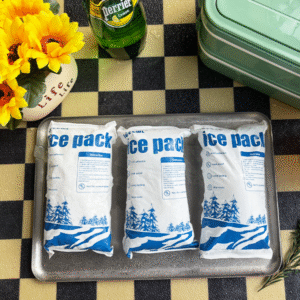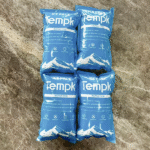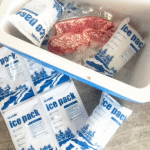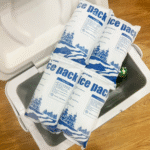Hazmat Dry Ice Pack: Sicheres Handling, Verpackung & 2025 Trends
Shipping a hazmat dry ice pack isn’t as simple as throwing frozen bricks into a box. Because dry ice is the solid form of carbon dioxide, it sublimates into CO₂ gas and can displace oxygen in enclosed spaces. Dieser Leitfaden zeigt how to package, label and ship hazmat dry ice packs safely while meeting DOT, IATA and USPS rules. You’ll learn why dry ice is classified as Class 9 Gefahrgut, how to choose the right container and how market trends in 2025 are reshaping the cold chain industry. Egal, ob Sie Impfstoffe versenden, steaks or cell therapies, understanding these principles protects your cargo and keeps you compliant.
What is a hazmat dry ice pack and why is it regulated?
How do you package and label a hazmat dry ice pack to prevent accidents?
Which regulations apply to air, ocean and ground shipments in 2025?
What are the pros and cons of dry ice packs versus gel packs and phase change materials?
What are the latest market trends and sustainable innovations for dry ice in 2025?
How can you calculate the right amount of dry ice and reduce your carbon footprint?
What Is a Hazmat Dry Ice Pack and Why Is It Regulated?
Definition and classification: Trockeneis ist festes Kohlendioxid. When it warms it SULBLIMATE directly into gas instead of melting, producing volumes of CO₂. In transport this gas can build pressure inside a sealed box, or displace oxygen and create asphyxiation hazards. Because of these risks, regulators classify dry ice as a Klasse 9 miscellaneous hazardous material with proper shipping name “Carbon dioxide, solid” or “Dry ice” and UN 1845 identification number. Dry ice becomes a regulated hazmat when shipped by air or vessel; ground shipments within the U.S. are generally exempt but still must meet packaging rules.
Hazards explained:
Oxygen displacement: CO₂ is heavier than oxygen and can push breathable air out of an enclosed cargo hold, was zum Ersticken führt.
Pressure build up: Als Trockeneis untermauert, gas pressure can rupture a sealed container.
Cold burn risk: Direct contact with dry ice can cause severe frostbite.
Due to these risks, carriers and regulators impose strict rules for handling hazmat dry ice packs. Understanding these rules helps you avoid fines and accidents.
Properties of Dry Ice and Pack Formats
Dry ice maintains an ultra cold temperature of –78,5 °C (–109 °F). Im Gegensatz zu Wassereis, it creates no liquid; instead the only by product is gas. Dry ice containers are insulated boxes (often made from high density polyethylene or expanded polystyrene) that hold bulk blocks or pellets and include vents to allow gas escape. Dry ice packs are smaller pouches or wraps containing pellets or slices designed to fit around individual products and deliver targeted cooling.
Different formats deliver different performance:
| Format | Typischer Temperaturbereich | Dauer | Beste Anwendungsfälle |
| Large dry ice block | –78,5 °C | Bis zu 72 H | Lange Sendungen, bulk cargo |
| Dry ice pellets/nuggets | –78,5 °C | 24–48 h | Quick cooling, processing lines |
| Dry ice slices/wraps | –78,5 °C | 24–48 h | Customized fit, small parcels |
| Gelpackungen | 0–10 °C | 12–24 h | Refrigerated meals, produzieren |
| Phasenwechselmaterial (PCMs) | 2–8 °C oder –20 °C | 24–96 h | Impfungen, biologics requiring narrow temperature bands |
Choosing the right format depends on your payload, transit time and regulatory constraints.
Die Wissenschaft der Sublimation
Sublimation means solid dry ice turns directly into gas without passing through a liquid phase. Because there’s no liquid, products stay dry—but the CO₂ gas must be vented to prevent overpressure. Proper ventilation is not just a good practice; it’s a safety requirement across all shipping modes. Containers should never be airtight; jerricans and steel drums are prohibited because they can explode.
How to Package and Label a Hazmat Dry Ice Pack
Verpackungsanforderungen
Regulators require that hazmat dry ice packs are packaged in sturdy, belüftete Behälter. According to hazmat training resources, packaging must allow the release of CO₂ gas to prevent pressure build up. FedEx 2025 Dry Ice Job Aid warns against using steel drums or sealed plastic bags; stattdessen, use high quality fiberboard, plastic or wooden boxes. If a plastic cooler is used, it must have holes or an open plug for ventilation.
A well insulated box with polystyrene foam can slow sublimation, but the foam must not be sealed airtight. Die USA. Postal Service (USPS) also notes that boxes should permit gas release and conform to 49 CFR § 173.217. Für Oberflächenpost, weight limits are more generous; for air mail, USPS restricts each mailpiece to 5 lbs aus Trockeneis.
Key packaging tips:
Use durable outer boxes made of fiberboard, plastic or wood.
Never place dry ice in airtight bags or metal drums.
Isolierung hinzufügen (Z.B., Polystyrol) but leave vent holes.
Ensure the container is strong enough for handling and stacking.
Weight Limits and Ventilation
International air transport rules limit the amount of dry ice per package to 200 kg. This applies to cargo or passenger aircraft. For passenger airlines, individual travelers can bring up to 2.5 kg (5.5 lbs) of dry ice without additional paperwork. Exceeding this amount triggers a dangerous goods declaration and more stringent packaging requirements.
Ventilation is non negotiable: dry ice releases gas that must escape. Carriers like FedEx explicitly instruct shippers not to seal containers completely and to avoid steel drums or jerricans. Even high quality insulated boxes require vent ports to avoid explosions.
Marking and Labeling
Proper marking allows carriers and emergency responders to identify hazmat dry ice packs quickly. Shippers must place the following on the package surface:
Richtiger Versandname: "Trockeneis" oder "Kohlendioxid", Solide". This name should appear near the hazard label.
UN -Nummer: "Und 1845".
Nettogewicht: The amount of dry ice in kilograms (1 kg = 2 lbs). The weight must be accurate to ensure compliance and help carriers calculate ventilation needs.
Klasse 9 Hazard -Etikett: A black and white diamond label at least 100 × 100 mm. Do not write inside the diamond border.
Shipper and consignee names and addresses: These must be durably marked on the package.
Für Lufttransporte, a Shipper’s Declaration for Dangerous Goods (DGD) may be required when dry ice accompanies dangerous goods. When dry ice is used to cool non dangerous goods, no declaration is needed; stattdessen, note the presence of dry ice on the air waybill.
Documentation Differences by Mode
Luft (Hier ist DGR): Packaging instruction 954 erlaubt bis 200 kg of dry ice in a package and permits non UN packaging, provided venting is allowed. The shipper must include the proper shipping name, UN -Nummer, and net weight on the package and may need to file a DGD for dangerous goods.
Ocean (IMDG Code): Similar to air rules, packaging must be strong and vented. Documentation is always required, even if dry ice cools non dangerous goods. Marking includes the proper shipping name and UN number; net weight is not mandatory for ocean shipments.
Boden (49 CFR § 173.217): Dry ice is exempt from hazmat regulations when shipped by road or rail in the U.S., but packaging must still allow venting and the shipper must mark the package appropriately. USPS permits up to 5 lbs for air mail and more for surface mail, with clear “Surface Only” markings.
Triple Packaging for Biological Materials
When dry ice cools infectious substances or diagnostic specimens, triple packaging is mandatory: an inner leak proof receptacle, a secondary leak proof container with absorbent material, and a strong outer box. The outer box must display the dry ice hazard label and net weight. This system protects handlers and prevents leaks if the primary container breaks.
Hazmat Dry Ice Pack Safety and Handling Tips
Safe handling of hazmat dry ice packs protects workers and recipients. Follow these tips to minimize risks:
Persönliche Schutzausrüstung (PS)
Isolierte Handschuhe: Dry ice can cause frostbite. Always use thermal gloves when handling pellets or blocks.
Eye protection: Wear safety goggles to guard against splinters and contact burns.
Aprons or lab coats: Protect your clothing and skin from accidental contact.
Belüftung und Lagerung
Store in ventilated areas: Do not store dry ice packs in airtight rooms or vehicle trunks. CO₂ can accumulate and displace oxygen.
Never seal containers: Always allow gas to escape through vents or partially open lids.
Avoid confined spaces: Do not enter small storage rooms or walk in freezers where dry ice is sublimating without testing oxygen levels.
Handling and Loading Procedures
Use tongs or scoops: Avoid direct contact with dry ice pellets. Use tools to transfer them into containers or packs.
Load last: When loading a vehicle, add dry ice packs just before departure to minimize sublimation loss.
Überwachen Sie die Temperatur: Use data loggers or thermal indicators to ensure the payload remains within the desired temperature range.
Disposal and Environmental Considerations
Lass es sublimieren: The safest way to dispose of dry ice is to leave it in a well ventilated area at room temperature until it turns into CO₂ gas. Entsorgen Sie niemals Trockeneis in Waschbecken, toilets or trash cans.
Carbon footprint: Because most industrial CO₂ is fossil derived, sustainability is a growing concern. Consider hybrid cooling solutions or bio based dry ice to reduce emissions.
Regulatory Overview for Hazmat Dry Ice Packs in 2025
Understanding the regulatory landscape helps you avoid violations. Here is a concise overview of the key regulations:
| Regulation/Agency | Key Provisions | What It Means for You |
| 49 CFR § 173.217 (PUNKT) | Dry ice regulated only by air and vessel; ground shipments exempt but must use vented packaging. | If shipping via highway or rail, you can use dry ice without hazmat certification but must mark the package correctly. |
| IATA-Gefahrgutvorschriften (Hier ist DGR) | Packanweisung 954 erlaubt zu 200 kg Trockeneis pro Packung; requires proper shipping name, Und 1845, Hazard -Etikett, net weight and venting. | Für Lufttransporte, Personalbetreuung, prepare an air waybill note or DGD, and limit weight accordingly. |
| IMDG Code (Ocean) | Requires vented, strong packaging; documentation is mandatory even when cooling non dangerous goods. | Always include shipping papers when using dry ice for ocean freight. |
| USPS Packaging Instruction 9A | Packages must permit gas release and conform to 49 CFR; for air mail, limit dry ice to 5 lbs and affix Class 9 label and “Carbon Dioxide Solid, UN1845” marking. | When mailing domestically, follow USPS weight limits and labeling rules; Internationale Post mit Trockeneis ist verboten. |
| FedEx Dry Ice Job Aid (2025) | Prohibits steel drums or sealed plastic bags; mandates labeling and net weight; sets class 9 label dimension at 100 mm; instructs using fiberboard or plastic boxes. | When using FedEx, follow their packaging instructions; mark both shipper and recipient addresses clearly and use proper label sizes. |
Choosing the Right Hazmat Dry Ice Pack for Your Cargo
Assess Your Temperature Needs
Ultra cold cargo: Materials such as vaccines requiring < –70 °C should be shipped with dry ice blocks or combination packs. Dry ice provides ultra cold temperatures and is cost effective for short durations.
Refrigerated cargo (2–8 ° C): Gel packs or PCMs suffice; they are non hazardous and reusable.
Frozen cargo (–20 °C): PCMs engineered to freeze at –20 °C maintain consistent frozen temperatures for 24–96 hours. They avoid the regulatory burden of dry ice.
Determine Duration and Transit Time
Kurze Sendungen (< 72 H): Dry ice blocks or slices maintain deep freeze for 48–72 hours.
Mittlere Sendungen (24–96 h): PCMs or hybrid systems combining dry ice and PCMs deliver stability for longer durations.
Lange Sendungen (> 96 H): Active refrigeration units may be needed. These units use battery power or external electricity but cost more and add complexity..
Consider Reusability and Sustainability
Gel packs and PCMs are reusable, reducing waste and long term costs. Dry ice is single use; once it sublimates, it’s gone. PCMs have higher upfront costs but lower regulatory burden and carbon footprint. Hybrid systems integrate PCMs with smaller amounts of dry ice, stretching hold times while minimizing hazmat handling.
Regulatory Complexity
Dry ice shipments require training, labeling and sometimes declarations, whereas gel packs and PCMs are mostly exempt. Evaluate your team’s capacity to handle hazmat training. If compliance is burdensome, PCMs may be a better choice.
2025 Trends and Innovations in Hazmat Dry Ice Packs
Market Dynamics: Supply and Demand
The dry ice market is under pressure. Consumption has been growing around 5 % pro Jahr, but CO₂ supply increases only 0.5 % pro Jahr, leading to shortages and price spikes. During supply crunches, spot prices can surge by 300 %. Despite volatility, global demand continues to rise; the market was valued at USD 1.54 Milliarden in 2024 and is expected to reach USD 2.73 Milliarden von 2032 (7.4 % CAGR). Das Wachstum wird durch den Lebensmitteltransport vorangetrieben, biologics and vaccine distribution, and industrial applications.
Industry Responses to Shortages
Manufacturers are addressing shortages by building localized production hubs and capturing CO₂ on site at facilities like food processing plants. Shippers are diversifying cooling strategies by combining dry ice with phase change materials and improving insulation to stretch each pound further. Long term supply contracts are replacing spot buying, ensuring critical sectors receive priority access during tight periods.
Sustainability Initiatives and Bio Based CO₂
Sustainability is becoming central. Food and pharma customers are pressuring suppliers to reduce the carbon footprint of dry ice. Since most industrial CO₂ comes from fossil sources, companies are exploring bio based CO₂ from bioethanol plants, where CO₂ released during fermentation can be captured and converted into dry ice. In Großbritannien, the Ensus bioethanol plant provides an estimated 30–60 % der CO₂-Versorgung des Landes. Jedoch, geopolitical factors and trade policies threaten these operations, underscoring the fragility of CO₂ supply.
Rise of Alternatives and Hybrid Cooling
Alternatives to dry ice are gaining traction. Gel packs and PCMs hold narrow temperature bands for refrigerated or frozen goods. Active mechanical refrigeration (battery powered or external power) is used for long haul pharmaceutical shipments but increases cost. Improved insulation materials—such as vacuum panels and curbside recyclable foam—reduce the amount of dry ice needed and support hybrid solutions. Hybrid systems combining small amounts of dry ice with PCMs are being adopted to reduce reliance on CO₂ while maintaining cold chain integrity.
Sector Specific Trends
Essen & Getränk: Shippers are using thinner dry ice slices and pellets for rapid cooling on processing lines. They invest in high performance insulated boxes to reduce sublimation losses.
Pharmazeutisch & Biotech: Companies are testing barrier technologies to slow CO₂ gas release and implementing real time temperature monitoring to avoid supercooling. Hybrid shipments using PCMs for less temperature sensitive medicines are becoming popular.
Industriell & Welding: Contractors invest in local pelletizing capacity to secure supplies and avoid being deprioritized during shortages.
Häufig gestellte Fragen
Q1: How much dry ice should I use in a hazmat dry ice pack?
The exact amount depends on your payload size, desired temperature and transit duration. Als Faustregel, allocate 5–10 lbs of dry ice per 24 Std. of transit for small packages. Use insulated containers to minimize sublimation losses. For shipments exceeding 200 kg, split the load into multiple packages to stay within IATA limits.
Q2: Can I ship dry ice with non hazardous items like frozen steaks?
Ja, dry ice is often used to ship frozen food. When cooling non dangerous goods, you don’t need a dangerous goods declaration—just mark the package with the proper shipping name, Und 1845 und Nettogewicht. Ensure the container vents CO₂ and follow airline or carrier weight limits.
Q3: Is dry ice allowed in ground shipping?
Dry ice is regulated only by air and vessel; ground shipments in the U.S. are generally exempt. Jedoch, packaging must still allow venting and the package should be marked. USPS allows more than 5 lbs for surface transportation, but air mail is limited to 5 lbs.
Q4: Are reusable dry ice packs better than single use?
Dry ice itself is inherently single use because it sublimates. Jedoch, you can reduce waste by using durable insulated containers and combining dry ice with PCMs that are reusable. This hybrid approach lowers overall CO₂ consumption and simplifies compliance.
Q5: What’s the difference between a hazmat dry ice pack and a gel pack?
A hazmat dry ice pack uses solid CO₂ to maintain –78,5 °C and is classified as hazardous; it requires labeling and weight limits. A gel pack uses a water based gel to keep products at 0–10 °C and is non hazardous. Gelpakete sind wiederverwendbar, easier to handle and suited for chilled goods.
Practical Tips and User Scenarios
Choosing the Right Packaging Scenario
Ship vaccines requiring ultra cold temperatures: Use a hazmat dry ice pack with large blocks to maintain –70 °C for 48–72 hours. Pre condition the container in a freezer and fill any empty space with additional dry ice slices. Attach a data logger to monitor temperature.
Send gourmet desserts or frozen meat: For same day or overnight delivery, wrap the product in an inner insulated bag and surround it with dry ice pellets. Ensure the box vents gas and mark it with “Dry Ice UN 1845” and net weight. You do not need a DGD when shipping non dangerous goods.
Transport biological samples: Use triple packaging and a combination of dry ice and PCMs to stabilize temperature. Clearly label the outer box with the infectious substance category, dry ice weight and hazard class. File a DGD if required by your carrier.
Domestic surface shipping via USPS: Keep the dry ice below 5 lbs for air transport or mark “Surface Only” if sending via ground. Include the contents description and weight on the address side of the package.
Fallstudie: Gene Therapy Shipment
Real example: A biotech firm needed to transport gene therapy vectors requiring temperatures below –60 °C. They used a hazmat dry ice pack with blocks and pellets layered together. By preconditioning the container and filling empty spaces with custom dry ice slices, they kept the temperature between –65 °C and –70 °C for 72 Std.. Real time monitoring ensured product integrity without supercooling, and proper labeling and documentation prevented delays.
Trockeneis vs. Gel Packs vs. PCMs: Welches ist am besten?
The table below summarizes the differences among dry ice, gel packs and phase change materials. This helps you decide which refrigerant fits your shipment.
| Kühlmethode | Temperaturbereich | Dauer | Hazard Class | Wiederverwendbarkeit | Beste Anwendungsfälle |
| Trockeneis (Co₂) | –78,5 °C | 48–72 h | Klasse 9 hazardous | Einmalgebrauch | Ultra cold shipments: Impfungen, gene therapy vectors, gefrorenes Fleisch |
| Gelpackungen (Water Based) | 0–10 °C | 12–24 h | Ungefährlich | Wiederverwendbar | Chilled foods, Mahlzeiten, produzieren |
| Phasenwechselmaterial (PCMs) | –20 °C or +2–8 °C | 24–96 h | Ungefährlich | Wiederverwendbar | Impfungen, biologics requiring narrow temperature bands |
| Hybrid (Trockeneis + PCM) | –20 to –70 °C | 48–96 h | Heimat (due to dry ice) | Reusable PCM portion | Long shipments requiring extended hold time; reduces amount of dry ice needed |
Interactive Tools and User Engagement
Creating an engaging experience helps users apply what they’ve learned and reduces bounce rate. Here are two interactive ideas you could implement on your website:
Dry Ice Quantity Calculator: An interactive widget where users enter the payload weight, desired temperature range and transit time. The calculator then estimates how many pounds of dry ice they need and suggests whether to use blocks, pellets or a hybrid system. This tool helps avoid over or under packing and ensures compliance.
Compliance -Checkliste: A self assessment quiz that asks users about their shipment (mode, Gewicht, Inhalt). It outputs a customized checklist of packaging, Markierung, documentation and training requirements. This encourages readers to engage with the content and share it with colleagues.
Zusammenfassung und Empfehlungen
Key Takeaways: Shipping a hazmat dry ice pack requires a combination of sturdy, Entlüftungsverpackung, clear labeling and adherence to regulations. Dry ice is a Class 9 hazardous material because it sublimates into CO₂ gas and can displace oxygen. Packages must be vented, marked with the proper shipping name, Und 1845, Nettogewicht und Klasse 9 Etikett. IATA rules limit dry ice to 200 kg pro Paket, while USPS allows only 5 lbs in air mail. Gel packs and PCMs provide non hazardous alternatives for higher temperature ranges. Market trends show that CO₂ supply shortages, sustainability pressures and hybrid cooling methods are reshaping the cold chain industry.
Umsetzbare nächste Schritte:
Evaluate your payload: Determine the required temperature range, duration and sensitivity of your goods.
Select the right refrigerant: Use dry ice only when necessary; consider gel packs or PCMs for chilled cargo.
Follow packaging rules: Use vented, durable boxes, avoid airtight containers and include all required markings.
Trainiere dein Team: Provide hazmat training for staff who pack, label or document dry ice shipments.
Monitor trends: Stay informed about CO₂ supply and sustainable innovations; consider hybrid systems to reduce your carbon footprint.
Aufruf zum Handeln: Ready to optimize your cold chain shipments? Assess your current packaging process and consider implementing a dry ice calculator or compliance checklist on your website. Proper planning and adherence to the guidelines above will keep your cargo safe, compliant and competitive in 2025.
Über Tempk
Tempk is a leader in reusable, eco friendly cold chain solutions. Our team combines material science with years of logistics experience to develop insulated boxes, Gelpackungen, phase change materials and hazmat dry ice packs that meet DOT and IATA standards. We focus on reducing waste through durable packaging and exploring bio based CO₂ sources for dry ice. Our solutions are designed for food, Pharma- und Biotech-Transporte, ensuring temperature integrity from factory to doorstep.
Get in touch: Consult our experts to select the right packaging for your shipment and learn how our hybrid systems can improve efficiency and sustainability.
























